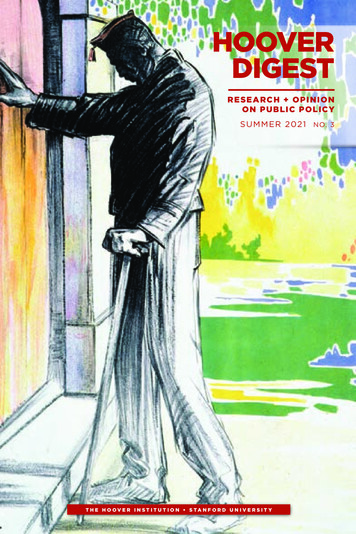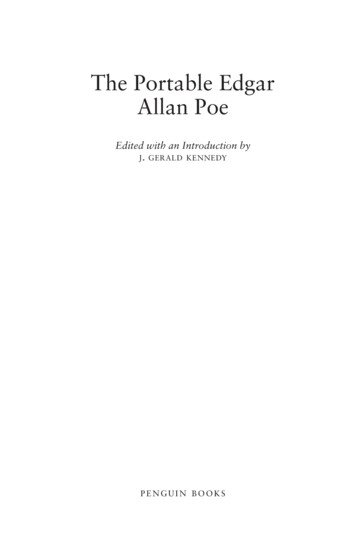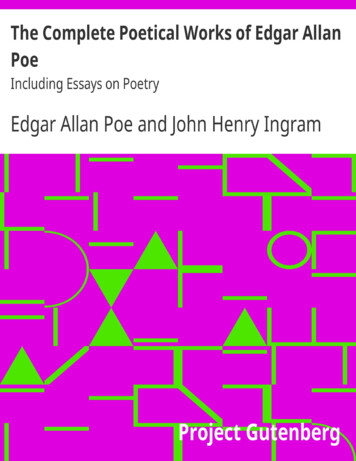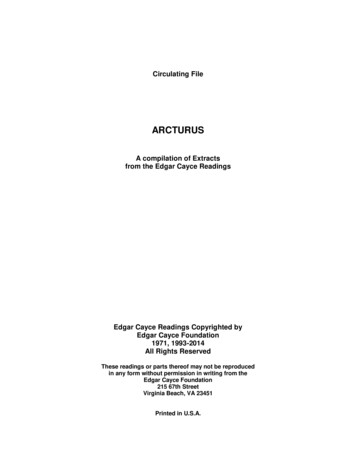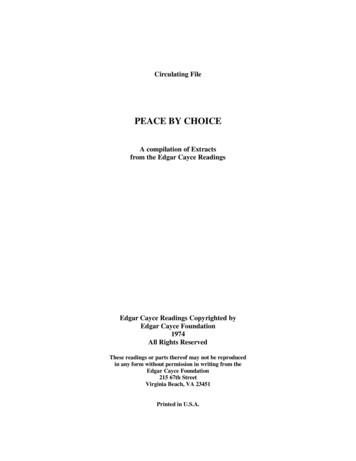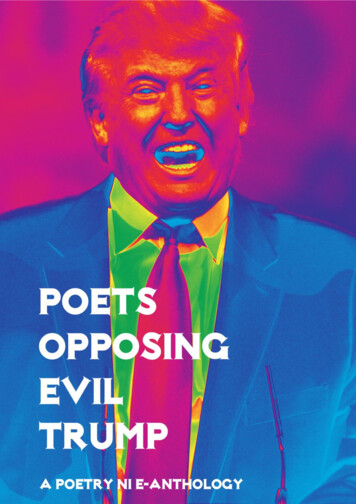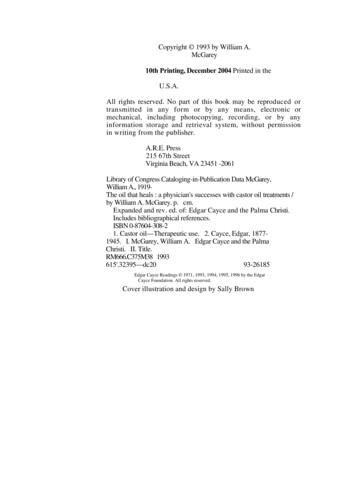
Transcription
CANDLEWICK PRESS RESOURCES AND ACTIVITIES FOR TEACHERSMaster of DeceitJ. Edgar Hooverand America inthe Age of LiesbyMarc AronsonABOUT THE BOOKJ. Edgar Hoover was the FBI’s first director. In thisunsparing exploration of one of the most powerfulAmericans of the twentieth century, accomplishedhistorian Marc Aronson unmasks the man behindthe Bureau — his tangled family history and personalrelationships; his own need for secrecy, deceit, andcontrol; and the broad trends in American societythat shaped his world. Using photographs, cartoons,ISBN: 978-0-7636-5025-4movie posters, and FBI transcripts, Master of Deceithelps readers to understand Hoover’s motives and the political climate of the United States in the twentieth century.Aronson’s balanced writing and meticulous research provide readerswith ample evidence, allowing them to draw their own conclusions as towhether or not Hoover’s methods were justified.As a teaching resource for the high-school classroom, Master of Deceitoffers a rich opportunity for students to practice critical thinking skillsand to consider the balance that must be struck by a government betweenproviding security and upholding the constitutional rights of its citizens.This guide provides classroom activities, materials, and suggested moviesthat can be used in conjunction with Master of Deceit. A discussion guide isalso available at www.candlewick.com.Hoover mapping the network of his offices07/12
CANDLEWICK PRESS RESOURCES AND ACTIVITIES FOR TEACHERSFrom the Cold Warto the War on TerrorThe following lesson and resources draw similaritiesbetween Hoover’s attempt to control the spread ofCommunism during the Cold War and the powers grantedto the federal government under the USA PATRIOT Act toconduct the “war on terror.”The right of the people to be secure in theirpersons, houses, papers, and effects, againstunreasonable searches and seizures, shall notbe violated, and no warrants shall issue, butupon probable cause, supported by Oath oraffirmation, and particularly describing theplace to be searched, and the persons or thingsto be seized.1. Begin the lesson by displaying the following quote onthe whiteboard:“Unthinking respect for authority is the greatestenemy of truth.” — Albert EinsteinPrior to passage of the USA PATRIOT Act, theFourth Amendment protected Americans againstunreasonable searches and seizures and required thegovernment to both obtain a warrant and give noticeto the person whose property is to be searched prior toconducting the search. The notice requirement alloweda property owner to assert his or her rights under theFourth Amendment. For example, a person given noticeof a warrant might be able to point out that the policeare at the wrong address or that since the warrant islimited to a search for a stolen car, the police have noauthority to be looking in the person’s dresser drawers.The Supreme Court has ruled repeatedly that providingnotice is a key Fourth Amendment protection.Ask students to explain what the quote means. Possiblequestions might be: What might people in power have to hide? What safeguards are in place to keep people in powerhonest? What avenues are available to show that we’renot happy with governmental decisions? Answers tothe first question might include freedom of the pressand the Freedom of Information Act. Answers to thesecond question might include peaceful protests, asprotected by the constitutional right to peacefullyassemble. The Occupy Wall Street protests offer acurrent-event idea to include in the discussion.2. Then display the following sentence:If you have nothing to hide, you have nothing tofear.Ask students how they feel about this statement.Additional questions might include:3. Discuss with your students two FBI activities that, in theBureau’s zeal to promote Hoover’s aims, directly violatedthe protections provided by the Fourth Amendment:black-bag jobs and COINTELPRO (Counter IntelligenceProgram). In order to protect society in general, doesn’t agovernment have the right to know what its citizensare doing? When cameras are placed in public places, doesn’tthat help police catch people who break laws? If every citizen of the United States were forced, bylaw, to submit a DNA sample, wouldn’t this makethe country a safer place? There are thousandsof unsolved crimes for which investigators havecollected DNA evidence, so wouldn’t this be a goodthing for stopping criminals?As part of the discussion, explain the rights protectedby the Fourth Amendment to the United StatesConstitution. The text of the Fourth Amendment reads:Ma ster of Deceit Te a c h e r s ’ R e s o u r c e sBeginning in 1942, the FBI engaged in illegal activitiescommonly known as black-bag jobs. The practicepermitted FBI agents to illegally enter offices oftargeted individuals and political organizations. Theowners of the homes or businesses were not notified,and FBI agents were able to enter and photograph theresident’s documents or other personal items.In 1966, Hoover claimed that he put an end to thispractice, which had been used by the agency for aquarter century. In 1972, in the Plamondon case, theSupreme Court ruled black-bag jobs unconstitutional.However, from the late 1960s through the 1970s, theagency routinely violated the Fourth Amendmentunder COINTELPRO, the federal effort to underminepolitical individuals and groups that the governmentopposed. w w w. c a n d l e w i c k . c o m page 2
CANDLEWICK PRESS RESOURCES AND ACTIVITIES FOR TEACHERSCOINTELPRO began in 1956 and was designed to“cause disruption and win defections” inside the U.S.Communist Party. The program was soon enlargedto include disruption of the Socialist Workers Party(1961), the Ku Klux Klan (1964), the Nation of Islam,the Black Panther Party (1967), and the entire New Leftsocial/political movement, which included antiwar,community, and religious groups (1968). A laterinvestigation by the Senate’s Church Committee statedthat COINTELPRO was started in 1956 out of frustrationwith Supreme Court rulings limiting the government’spower to proceed overtly against dissident groups.Congress and several court cases later concluded thatthe COINTELPRO operations against Communistand socialist groups exceeded statutory limits on FBIactivity and violated constitutional guarantees offreedom of speech and association.Share the following excerpted report from theDepartment of Justice with the students. The purposeof this report was to assert that delayed-notice warrantsare legal and have been used successfully by lawenforcement officials.Excerpted from the U.S. Department of Justice,“Delayed Notice Search Warrants: A Vital and TimeHonored Tool for Fighting Crime,” September 2004:September 22, 2004Dear Mr. Speaker,The USA PATRIOT Act has been invaluable tothe Department of Justice’s efforts to preventterrorism and make America safer while at thesame time preserving civil liberties. By passingthe USA PATRIOT Act, Congress provided lawenforcement and intelligence authorities withimportant new tools needed to combat theserious terrorist threat faced by the United States.None of the files containing information gatheredunder COINTELPRO were even known outside the FBI,and because none of the files were considered “official,”members outside the FBI had no access to them.During the early stages of criminalinvestigations, including terrorisminvestigations, keeping the existence of aninvestigation confidential can be critical to itssuccess. . . . In appropriate circumstances thegovernment can petition a court to approve adelayed-notice search warrant and thus avoidtipping off the suspect to the existence of acriminal or terrorist investigation. A delayednotice warrant is exactly like an ordinarysearch warrant in every respect except that lawenforcement agents are authorized by a judge totemporarily delay giving notice that the searchhas been conducted.COINTELPRO was successfully kept secret until1971, when a group of left-wing radicals callingthemselves the Citizens’ Commission to Investigatethe FBI burglarized an FBI field office in Media,Pennsylvania, took several dossiers, and exposed theprogram by passing this information to news agencies.Within the year, Director Hoover declared that thecentralized COINTELPRO was over and that all futurecounterintelligence operations would be handled on acase-by-case basis.4. Next, bring the discussion up to the current day witha look at the Patriot Act, passed following the terroristattacks of September 11, 2001.One provision of the act is the allowance of “delayednotice” search warrants. Also known as “sneak-andpeek” warrants, these give the FBI the ability to entera suspect’s home and seize property, take informationfrom computers, and make copies of documentswithout notifying the owner of the property. Recordsindicate that in the years immediately following 2001,very few of these warrants were executed. However,beginning in 2007, the numbers have been increasingdrastically. New York magazine reported that delayednotice search warrants issued under the expandedpowers of the Patriot Act from 2006 to 2009 weresignificantly higher for drug-related investigations(1,618) than for terrorism (15) (Benjamin Wallace-Wells.“Patriot Act.” New York, August 27, 2011. t-act/).Ma ster of Deceit Te a c h e r s ’ R e s o u r c e sThe report includes examples of successful operationsthat entailed delayed-notice search warrants:I. Terrorism InvestigationsIn the spring of 2003, a court-authorizeddelayed-notice search warrant allowedinvestigators to gain evidence of a plan to shipunmanned aerial vehicle (UAV) componentsto Pakistan, but to gain that evidence withoutprompting the suspects to flee the country.The UAVs at issue would have been capable ofcarrying up to 200 pounds of cargo, potentiallyexplosives, while guided out of line of sight by alaptop computer. Delayed notice of a search ofemail communications provided investigatorsinformation that allowed them to defer arrestingthe main suspect, who has since pleaded guilty,until all the shipments of UAV components hadbeen located. w w w. c a n d l e w i c k . c o m page 3
CANDLEWICK PRESS RESOURCES AND ACTIVITIES FOR TEACHERSII. Drug InvestigationsIn 2002, as part of an investigation intomethamphetamine trafficking, the DEA learnedthat suspects were preparing to distributea large quantity of methamphetamine inIndianapolis. Openly seizing the drugs wouldhave compromised an investigation reaching asfar as Alabama, Arizona, California and Hawaii;not seizing the drugs would have resulted intheir distribution. With a court’s approval, DEAagents searched the stash location and seized8.5 pounds of methamphetamine withoutproviding immediate notice of the seizure. Inthe wake of the drugs’ disappearance, two mainsuspects had a telephone conversation aboutthe disappearance that provided investigatorsfurther leads, eventually resulting in the seizureof fifteen more pounds of methamphetamineand the identification of other members ofthe criminal organization. More than 100individuals have been charged with drugtrafficking as a part of this investigation, and anumber have already been convicted.The full report is available at .United States?” Point out that students should useevidence that has been provided in the lesson in theiranswer. Explain to the students that their writtenresponse will be read by other students with opposingviewpoints and that the other students will be able torespond to their statements. By doing this, studentsare writing for their peers rather than writing for theteacher.Additional Resources For more examples of instances in which federal courts haveupheld delayed-notice warrants before the Patriot Act, seethese rulings:Dalia v. United States, 441 U.S. 238 (1979)United States v. Freitas, 800 F.2d 1451 (9th Cir.1986)United States v. Simons, 206 F.3d 392 (4th Cir. 2000)United States v. Villegas, 899 F.2d 1324 (2d Cir. 1990) The Church Committee Report, more specifically the FinalReport of the Select Committee to Study GovernmentalOperations with Respect to Intelligence Activities, BookIII: Supplementary Detailed Staff Reports on IntelligenceActivities and the Rights of Americans, 1976. Available at theMary Ferrell Foundation website, howDoc.do?docId 1159. Thisreport offers an overview of the tactics (legal and illegal)used by the FBI from 1948 to 1975.5. Have the students engage in a “three-corner debate.”On poster board, write out three different options toanswer the question “Should sneak-and-peek warrantsbe allowed in the United States?” and place themin different corners of the room. The first answer is“No, these laws violate the Fourth Amendment ofthe Constitution, which allows citizens to challengewarrants.” The second answer is “These warrants shouldbe allowed because they help police enforce laws.” Thethird answer is “I’m not sure how I feel about them.” “The Patriot Act: Key Controversies” by Larry Abramsonand Maria Godoy, NPR, December 16, 2005. tactdeal.html. Thisreport details the controversial portions within the PatriotAct. It offers the reader opinions of both the critics and theproponents of each provision and is an excellent way tostimulate debate on the issues contained within the PatriotAct.At this point, ask students to take their place in thecorner that best fits their opinion. Then ask studentsin each corner to try to persuade students with otherviewpoints to “come to their corner.” It is imperativethat the teacher act as “devil’s advocate” and try toconvince students to change their mind. It is equallyimperative that the teacher does not share his or herpersonal views on the matter. The activity ends whenthere is no more movement among groups. However,by the end of the activity, no students may stay in theundecided group.Advise and Consent (1962): the first Hollywood film to dealwith homosexuality, blackmail, politics, and power (p. 142) The following movies are mentioned in Master of Deceitand can be used as additional resources to help studentsunderstand important concepts in the book:Bonnie and Clyde (1967): an example of how the robbercouple had become heroes by the 1960s (p. 186)Creature from the Black Lagoon (1954): more danger —and desire — welling up from the deep (p. 131)Gentleman’s Agreement (1947): Elia Kazan’s Oscar-winningfilm about anti-Semitism in the U.S. (p. 146)Good Night, and Good Luck (2005): depicts Edward R.Murrow taking on Senator McCarthy (p. 149)Guys and Dolls (1955): details New York in the time ofWalter Winchell (p. 59)As an alternative to the three-corner debate, you couldask the students to write an answer to the question“Should delayed-notice warrants be allowed in theMa ster of Deceit Te a c h e r s ’ R e s o u r c e sInvasion of the Body Snatchers (1956): a film about thedangers of conformity (p. 114) w w w. c a n d l e w i c k . c o m page 4
CANDLEWICK PRESS RESOURCES AND ACTIVITIES FOR TEACHERSJ. Edgar (2011): Clint Eastwood film that includes thePalmer Raids — lacking in historical accuracy in placesbut useful as counterpoint to Master of Deceit (p. 189)Spartacus (1960): a popular Oscar-winning film thatessentially marked the end of the blacklist, in both itssubject matter and by the public involvement of DaltonTrumbo (p. 169)Kiss Me Deadly (1955): depicts the 1950s era, portrayinga strong FBI fighting evil, corrupt criminals (p. 119)The Street with No Name (1948): the story of the FBI asHoover wanted it told (p. 117)Little Caesar (1931): the story of organized crime inChicago (p. 56)The Sweet Smell of Success (1957): a fictionalized versionof true aspects of Walter Winchell’s life, capturing hispersonality and power (p. 161)On the Waterfront (1954): Elia Kazan’s film portraysbreaking with the union and naming names as an actof heroism (p. 146)You Can’t Get Away with It! (1936): a depiction of crimefighting from Hoover’s perspective (p. 62)Persons in Hiding (1939): the Bonnie and Clyde storyfrom J. Edgar Hoover’s point of view (p. 35)Ten Days that Shook the World (1928): film by Sovietdirector Sergey Eisenstein that details the RussianRevolution (p. 2)Point of Order (1964): a documentary that includesactual dramatic highlights of the Army-McCarthyhearings (p. 151)And last, a play rather than a film:Public Enemies (2009): a contemporary take on thegangster era, featuring the exploits of Melvin Purvis(p. 189)The Crucible (1953): Arthur Miller’s brilliant playportrays the refusal to name names as an act of heroism(p. 147).The Public Enemy (1931): a depiction of the mood ofthe United States during the Great Depression as wellas the glamorization of the gangster lifestyle (p. 48)Reds (1981): John Reed, the Russian Revolution, andCommunism and the left in America (p. 10)ALSO BY MARC ARONSON:Pick-Up Game: A Full Day of Full Courtco-edited with Charles R. Smith Jr.HC: 978-0-7636-4562-5War Is . . . Soldiers, Survivors, and Storytellers Talk About Warco-edited with Patty CampbellHC: 978-0-7636-3625-8 PB: 978-0-7636-4231-0ABOUT MARC ARONSONMarc Aronson has a doctorate in American history and is a member of the graduate facultyof the library school at Rutgers. He is an editor and author of many award-winning booksfor young people, including Sir Walter Ralegh and the Quest for El Dorado; War Is . . . Soldiers,Survivors, and Storytellers Talk About War, which he co-edited with Patty Campbell; and mostrecently, Trapped: How the World Rescued 33 Miners from 2,000 Feet Below the Chilean Desert.Marc Aronson lives in New Jersey.This guide was written by Jason L. O’Brien, assistantprofessor at the University of Alabama in Huntsville,in collaboration with Marc Aronson.Ma ster of Deceit Te a c h e r s ’ R e s o u r c e s w w w. c a n d l e w i c k . c o m page 5
Master of Deceit Teachers' Resources www.candlewick.com page 3 C A N D L E W I C K P R E S S R E S O U R C E S A N D A C T I V I T I E S F O R T E A C H E R S COINTELPRO began in 1956 and was designed to "cause disruption and win defections" inside the U.S. Communist Party. The program was soon enlarged .
